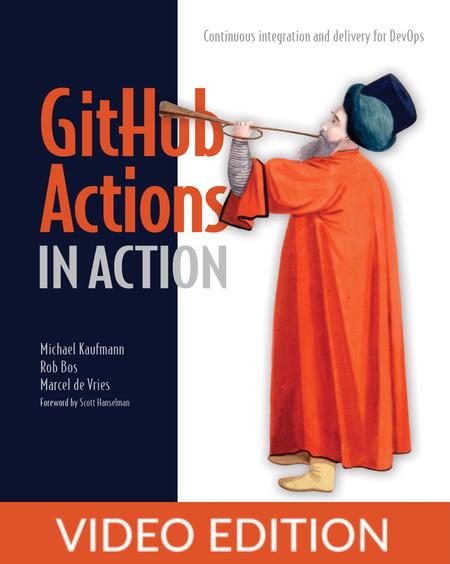English | MP4 | AVC 1280×720 | AAC 44KHz 2ch | 6h 14m | 980 MB
Automate your build, test, and deploy pipelines using GitHub Actions!
Continuous delivery (CI/CD) pipelines help you automate the software development process and maximize your team’s efficiency. GitHub Actions in Action teaches you how to build, test, and deploy pipelines in GitHub Actions through hands-on labs and projects.
In GitHub Actions in Action you will learn how to:
- Create and share GitHub Actions workflows
- Automate CI/CD workloads and other GitHub tasks
- Secure release pipelines with secrets, variables, and environments
- Support compliance frameworks
- Create safe and scalable self-hosted runners
Written by three Microsoft MVPs and tech reviewed by a Staff DevOps Architect from GitHub, this book delivers the hardworking skills and advice you’ll need to be successful on the job. DevOps engineers will love GitHub Actions in Action’s coverage of reliable methods for Infrastructure-as-Code and automating cloud environments. You’ll follow an extended example application for selling tickets, taking it all the way from initial build to cloud deployment.
Believe it or not, CI/CD can be simple! With GitHub Actions, you can automate your entire dev process using just the tools built into GitHub—no external frameworks or complex integrations required. GitHub Actions is secure, reliable, and best of all, easy. This book will get you started.
GitHub Actions in Action teaches you how to build automated delivery pipelines in GitHub. You’ll start with simple examples that demonstrate workflow and action basics, and then you’ll dive into platform architecture, security, and workflow runtime details. As you go, you’ll build a full CI/CD pipeline, optimizing for compliance, performance, and costs. You’ll even create shareable actions for the GitHub marketplace.
What’s inside
- Create and share GitHub Actions workflows
- Automate testing and other GitHub tasks
- Secure release pipelines with secrets, variables, and environments
Table of Contents
Part 1. Action fundamentals
Chapter 1. Introduction to GitHub Actions
Chapter 1. What are GitHub Actions and workflows?
Chapter 1. GitHub Actions: More than CI/CD pipelines
Chapter 1. Hosting and pricing for GitHub and GitHub Actions
Chapter 1. Conclusion
Chapter 1. Summary
Chapter 2. Hands-on: My first Actions workflow
Chapter 2. Using the workflow editor
Chapter 2. Using actions from the marketplace
Chapter 2. Running the workflow
Chapter 2. Conclusion
Chapter 2. Summary
Chapter 3. Workflows
Chapter 3. The workflow syntax
Chapter 3. Events and triggers
Chapter 3. Workflow jobs and steps
Chapter 3. Expressions and contexts
Chapter 3. Workflow commands
Chapter 3. Secrets and variables
Chapter 3. Workflow permissions
Chapter 3. Authoring and debugging workflows
Chapter 3. Conclusion
Chapter 3. Summary
Chapter 4. GitHub Actions
Chapter 4. Authoring actions
Chapter 4. Hands-on lab: My first Docker container action
Chapter 4. Sharing actions
Chapter 4. Advanced action development
Chapter 4. Best practices
Chapter 4. Conclusion
Chapter 4. Summary
Part 2. Workflow runtime
Chapter 5. Runners
Chapter 5. Queuing jobs
Chapter 5. The runner application
Chapter 5. GitHub-hosted runners
Chapter 5. Hosted operating systems
Chapter 5. Installed software
Chapter 5. Default shells
Chapter 5. Installing extra software
Chapter 5. Location and hardware specifications of the hosted runners
Chapter 5. Concurrent jobs
Chapter 5. Larger GitHub-hosted runners
Chapter 5. GitHub-hosted runners in your own Azure Virtual Network
Chapter 5. Billing GitHub-hosted runners
Chapter 5. Analyzing the usage of GitHub-hosted runners
Chapter 5. Self-hosted runners
Chapter 5. Summary
Chapter 6. Self-hosted runners
Chapter 6. Security risks of self-hosted runners
Chapter 6. Single-use runners
Chapter 6. Disabling self-hosted runner creation
Chapter 6. Autoscaling options
Chapter 6. Summary
Chapter 7. Managing your self-hosted runners
Chapter 7. Monitoring your runners
Chapter 7. Runner utilization and capacity needs
Chapter 7. Monitoring network access
Chapter 7. Internal billing for action usage
Chapter 7. Summary
Part 3. CI/CD with GitHub Actions
Chapter 8. Continuous integration
Chapter 8. Why continuous integration?
Chapter 8. Types of CI
Chapter 8. Generic CI workflow steps
Chapter 8. Preparing for deployment
Chapter 8. The CI workflows for GloboTicket
Chapter 8. Conclusion
Chapter 8. Summary
Chapter 9. Continuous delivery
Chapter 9. Using environments
Chapter 9. Deployment strategies
Chapter 9. Summary
Chapter 10. Security
Chapter 10. Managing untrusted input
Chapter 10. GitHub Actions security
Chapter 10. Supply chain security
Chapter 10. Summary
Chapter 11. Compliance
Chapter 11. How to enforce the four-eyes principle
Chapter 11. Mandatory workflows
Chapter 11. Summary
Chapter 12. Improving workflow performance and costs
Chapter 12. Reducing the costs of maintaining artifacts
Chapter 12. Improving performance
Chapter 12. Optimizing your jobs
Chapter 12. Summary
Resolve the captcha to access the links!
